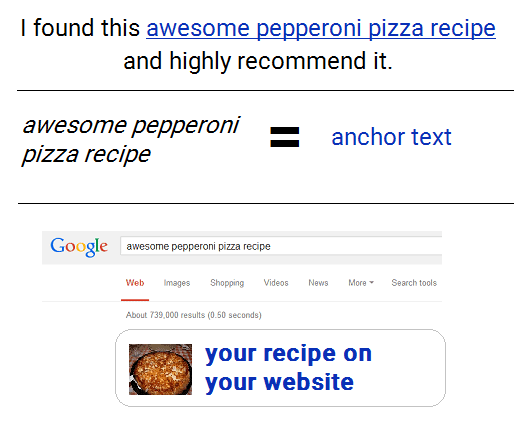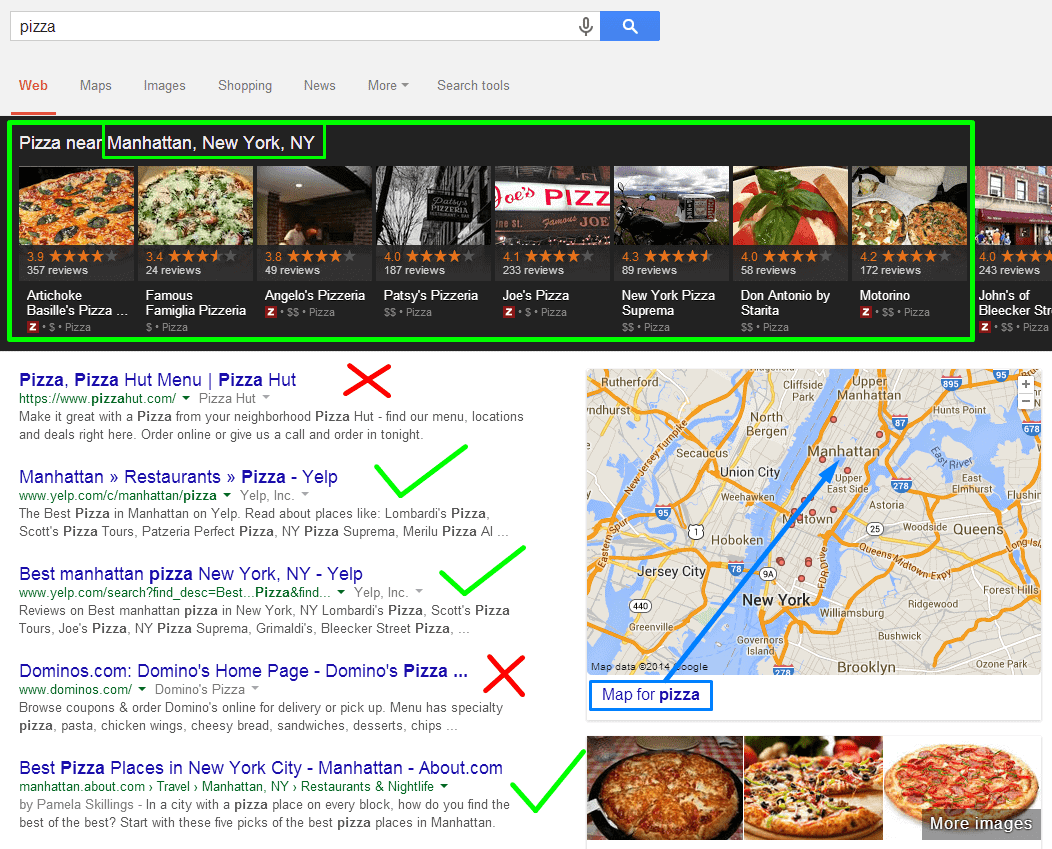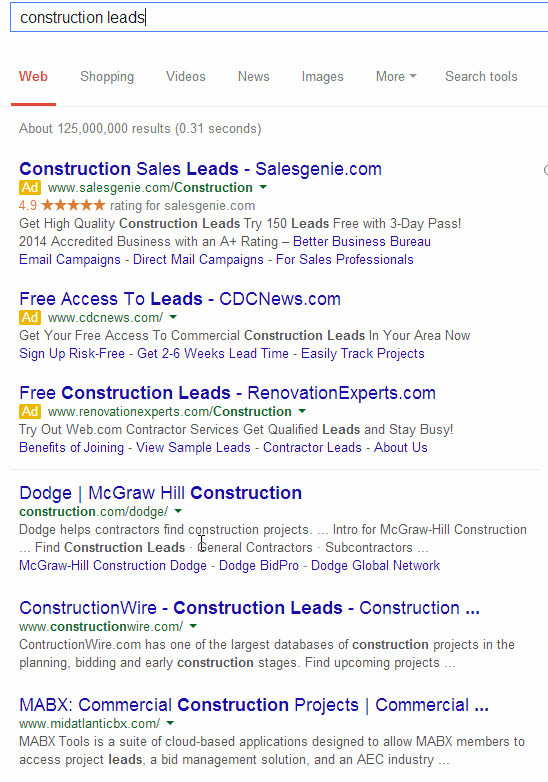Just as people are connected through family, relationships, schools, and organizations, the internet is connected through links. A link is much more than clickable text; it’s a signal that tells search engines—such as a Google and Bing—how pages connect and which pages are popular.
Links can help businesses of all sizes build their online presence, drive traffic to their site, and increase sales. For these reasons, it’s important for all small business owners to have a good understanding of links and how to acquire them in a natural, accepted manner.
Definition of inbound link building
In case you’re unfamiliar with the term, an inbound link — also known as a backlink — is any hyperlink on another website that directs users to a page on your website. This yields inbound traffic to your site, hence the term “inbound links.” These types of links are important because they introduce new visitors to your site—referrals—and they’re used by search engines like Google to measure a site’s popularity and weigh the results of online searches.
The text used in a hyperlink is known as anchor text. The anchor text tells users and search engines what the linked page is about. For example, if a pizza review site uses the anchor text “best pepperoni pizza recipe” in a link to a page on our site which features our pepperoni pizza recipe, this tells Google that when people search for “best pepperoni pizza recipe” our recipe page should show up higher in the results. In a nutshell, it’s a popularity contest—the more links we have with that anchor text, the higher up we’ll be ranked in search result pages. For example:

Finally, links contain a certain level of “popularity power” (a.k.a. PageRank) that is passed to your website. The influence of this power depends on how popular the site is that links to you. For example, a link from the New York Times impacts your search results much more than a link from a one-man blog with a handful of monthly readers.
Strategies for acquiring natural inbound links
As you may have begun to realize, acquiring inbound links—or rather—ranking higher in search result pages is instrumental to any business. The SEO industry heavily studies and tests methods to improve these rankings, and inbound links are one of the primary influencing factors.
In layman’s terms, there are two ways to approach acquiring links. One is accepted, and the other is generally shunned. We’ll cover both so you can stick to best practices and avoid dabbling in shady tactics.
News, press releases, updates, and email
As a small business, increasing the number of inbound links you receive should not be a primary goal; rather, a byproduct of developing a unique brand, quality products, and establishing yourself as an authority in your niche.
By creating a blog on your website, you increase opportunities to acquire natural links. Building up a list of email subscribers allows you to immediately reach current and potential customers who may share your pages on their web properties and among their own networks.
Generally speaking, it’s difficult for a small business to consistently produce newsworthy content. The initial launch phase of any business lends itself to being picked up by publications and shared, but this initial attention is fleeting. This is why emphasizing and focusing on building an authority website can help others organically find and link to your website as something they trust. When visitors land on our website and find value in our services or content, it’s the perfect moment to have them subscribe to our feed and stay updated.
Think about how we might acquire a link in this manner. We send out an email about a new product launch or a new video. One of our readers shares it with their social networks and it gets picked up by another site, who credits us with a link—maybe a positive review too!
When launching additional services, locations, and fundraisers, write press releases and blast them out to local publications. Your marketing or communications manager will build relationships with journalists and bloggers to help receive press coverage while grabbing a few inbound links in the process.
Verify your business on Google My Business
If you’ve ever done a quick search for pizza in your neighborhood, you’ve probably noticed a lot of results have Google reviews attached to them.

These reviews are part of Google My Business, otherwise known as Google’s business directory. They mix in Zagat’s feature system along with official Google Reviews and Ratings.
Verifying your business on Google is a necessity. This allows you to freely and safely rank for your brand and highly relevant service/product offers in specific locations. A vital aspect of this is showing up clearly across Google’s Search, Maps, and Google+ on both desktop and mobile devices.
Thinking forward, this makes it easy and natural for bloggers who write reviews of products to find your business, become a customer, and write a (hopefully) positive review with a link to your website.
Optimize pages for single and multiple locations
As we’ve just covered, verifying your business on Google—which is free—gives small, localized businesses a big SEO advantage. Typically, the competition for locally based keywords is relatively low. You can dedicate entire pages to local keywords and naturally rank for them. This is a natural search process that is beneficial to searchers.
If we search for “orthodontist in ” and we have a page that is dedicated to that term, we should be at the very top of the search results:

Gaining links with the anchor text “orthodontist” still helps rank for “orthodontist in pikeville ky” because the practice is verified with Google. This is why page optimization is a vital part of getting relevant inbound links to your site.
But what if our business isn’t hyperlocal? What if we’re still considered a small or medium-sized business but we have multiple locations in a few different states?
This is where optimizing pages for multiple locations and securing inbound links with relevant anchor text becomes a huge factor. To get a better idea of how a business might approach this strategy, let’s look at the difference in results with a competitive keyword and that same competitive keyword with a state acronym appended to the beginning.
The competitive keyword = construction leads
The state-appended version = de construction leads
Here’s a visual demonstration of how adding “de” completely alters search results:

Since we’re dealing with a highly competitive keyword that cannot solely receive assistance from being verified with Google, optimizing pages for our multiple locations gives us a proper angle to approach heavy competition. In this example, the company Mid Atlantic BX is clearly targeting Delaware with an optimized location page. To get a better idea of how to implement this on your own business, reference their regions page which branches out into the five states they target. This should help those unaccustomed to page optimization build a strong foundation for enacting it on their own website.
After creating optimized pages for specific locations, businesses can acquire inbound links to those pages both naturally and by reaching out to relevant and trusted publications, directories, and listings. When submitting your business to a directory or an industry listing, use good judgment and stick to trusted sites. For example, the American Association of Orthodontists would be a trusted directory to receive a backlink from, but avoid a suspicious site filled with advertisements that might be named something along the lines of “best-orthodontist-directory.”
Create forms of shareable content
Blogs are not only a medium to tell a story as a business owner, but also a way to naturally earn links. Well-written, natural tone blog posts make it easy for new visitors to connect with your business and develop a more personable disposition. While blogging can seem like a time-vacuum for business owners, modern marketing teams know the importance of establishing a consistent blogging schedule with unique content.
Did one of your employees bring in a pet? Take photos and let them write a short story about it. Blogs can help co-workers feel more connected to their business identity, and they’ll naturally share the posts they write among their own networks. As posts (and their linking URLs) are shared across social networks, they can send referral traffic and get linked to from new sites.
In addition to general blog posts, many businesses are creating infographics (short for “information graphics”) which give meaningful facts and statistics in an image. Infographics are some of the most shared content on the Internet. By creating something timely and relevant to your business, other websites can “host” or “embed” your media—whether it’s an infographic, video, or photo—on their website and credit your website with a link. Additionally, 95% of consumers prefer companies that provide engaging/valuable content and 76% of business-to-business consumers prefer receiving content unique to their buying stage. This means focusing on engaging, relevant stories and strategically promoting them to visitors who can be nurtured into loyal customers.
Strategies to avoid
Although there are many good inbound link building strategies, there are definitely a few bad ones. Engaging in these tactics can end up getting your site de-indexed from search engines. Here are a few examples of link building strategies you should avoid:
Automated link building
Automated link building is a fancy way of referring to spammers. They use third-party software to create fake profiles and post random comments with links on any website that does not heavily restrict comments. They will also use automated tools to create bare-bones websites and heavily link out to their websites in “scraped” blog posts (essentially plagiarism). Outdated or shady SEO firms may still practice these tactics, so always perform due diligence when considering outsourcing an SEO agency.
Paying for links
The purchasing of links is strictly forbidden by Google. There are many low-quality directory sites on the internet that request small fees to have your listing included—avoid these sites like the plague. Also be skeptical of any emails or comments you receive that offer to acquire links for you, in return for an undisclosed amount of money. Here’s some advice straight from Google’s mouth:
“The best way to get other sites to create high-quality, relevant links to yours is to create unique, relevant content that can naturally gain popularity in the Internet community. Creating good content pays off: Links are usually editorial votes given by choice, and the more useful content you have, the greater the chances someone else will find that content valuable to their readers and link to it.”
Final words
As discussions arise on social networks, forums, blogs, and publications relevant to your industry, opportunities arise to make an appearance. These opportunities may be in the form of extending your customer service arm to help resolve public issues or referencing content on your own website with a helpful and relevant link. For example, a local mechanic can apply their expertise by creating an educational piece of content on their website, such as “how to change your spark plugs.” When the mechanic happens upon a question about this topic on another website, they might want to leave a helpful comment including a link to their own piece of content.
Though minor, comment and forum links can help your search results too. However, thousands of spammy robots plague forums and comment sections with irrelevant links and broken English. The amount of spam has put many webmasters on guard when it comes to their comment sections. But if you offer honest advice and include a relevant link, you can cement a real brand identity and send referral traffic to your website.
When trying to increase your number of inbound links, remember that any links to your site should help end users. The goal of inbound links isn’t just to help improve your visibility in search engines—it’s to help satisfy the intent and expectations of searchers. Every blog post you read is an opportunity to practice this; give it a try now by leaving a comment below!

